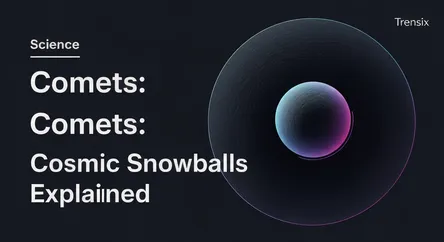Science
Comets: Cosmic Snowballs Explained

Discover comets, the icy wanderers of our solar system. Learn what they're made of, why they have tails, and their role in cosmic events.
What is it?
A comet is a small celestial body made of ice, rock, and dust that orbits the Sun. Often called "dirty snowballs," these objects originate in the far reaches of the solar system, primarily the Kuiper Belt and the Oort Cloud. As a comet approaches the Sun, the heat causes its ice to sublimate, releasing gas and dust. This creates a glowing atmosphere around its nucleus, called a coma, and one or more distinctive tails that can stretch for millions of kilometers, always pointing away from the Sun.
Why is it trending?
Comets capture public attention whenever a particularly bright one becomes visible from Earth, like the anticipated Comet C/2023 A3 (Tsuchinshan-ATLAS). Scientific missions that study comets up close, like the Rosetta mission to Comet 67P, also generate significant buzz. Researchers are fascinated by comets because they are pristine remnants from the formation of our solar system, about 4.6 billion years ago. They may hold clues about the origins of water and organic molecules on Earth, the very building blocks of life.
How does it affect people?
Historically, comets were often viewed as bad omens. Today, they inspire awe and scientific curiosity. They provide spectacular viewing opportunities for amateur and professional astronomers alike, fostering a public interest in space. While a major comet impact poses a theoretical threat to Earth, such events are exceedingly rare. Primarily, comets affect us by expanding our understanding of the universe's history and the processes that led to the formation of planets, including our own. They are cosmic time capsules that help answer fundamental questions about where we came from.